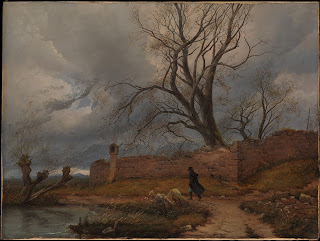German Romanticism was a movement that valued the beauty of nature. The main focuses within the art during this movement were restlessness and longing for what is out in the world. The young artists of this time period saw a push for industrialization in the world and all of these artworks are a reaction to that. German Romanticism was a yearning to find a man’s true place in the natural world. The artists thought that through art, they could communicate a more free and simple way of life.
The purpose of German Romanticism art was to allow people to sit back and really take in the weight of their relationship with nature. The thought was that nature has a place in all of our minds and it needs to be realized. There have been many artists throughout this movement including the likes of Julius von Leypold and Caspar David Friedrich. Many of the paintings show human figures with their backs turned towards the viewer to look at nature in pure awe of its possibilities. Most of the figures are also small which shows the size comparison between humans and nature, making us appreciate it even more. In this exhibit, we will take a look at how artists have depicted their view of nature in different ways during the German Romanticism period.
Artist: Julius von Leypold (German, Dresden 1806–1874 Niederlößnitz)
Date: 1835
Medium: Oil on canvas
Museum: MET 2008.7
Title: Woman at a Window
Artist: Caspar David Friedrich (German, Greifswald 1774–1840 Dresden)
Date: 1822
Medium: Oil on canvas
Museum: Nationalgalerie, Staatliche Museen zu Berlin
This painting was done by Caspar David Friedrich and it depicts a young woman looking out the window of Friedrich’s studio. The inside of the studio seems to be very void of any life which makes this artwork feel lonely. The way that the woman is looking out into the world brings a sense of loneliness and calls for nature. There is a heavy theme of Romanticism in this work because her back is faced away from our view and she is fixated on the outside world.
Title: Two Men Contemplating the Moon
Artist: Caspar David Friedrich (German, Greifswald 1774–1840 Dresden)
Date: ca. 1825–30
Medium: Oil on canvas
Museum: MET 2000.51
This painting by Caspar David Friedrich depicts two men standing together gazing at the beauty of the moon. Friedrich is the man on the right and his friend is on the left of him. In German Romanticism, there has always been an attraction to the moon. The main purpose of this painting is to pause and appreciate the nature that we have around us. As viewers of this piece, we can connect with the two men because we see them from the backside and have a clear view of what they see.
Title: Eastern Coast of Rügen Island with Shepherd
Artist: Caspar David Friedrich (German, Greifswald 1774–1840 Dresden)
Date: ca. 1805–6
Medium: Sepia colored ink, sepia colored wash, white gouache and graphite on off-white wove paper
Museum: MET 2002.260Caspar David Friedrich based this piece on sketches he made on the island of Rügen, in the Baltic Sea. This island is close to the area where Friedrich was born. The size of the figures in the artwork really help to show how tiny humans are. The landscape that we see seems to go on forever until it fades out. German Romanticism is emphasized here by showing a lonely figure in a huge area of land.
Title: Two Men before a Waterfall at Sunset
Artist: Johan Christian Dahl (Norwegian, Bergen 1788–1857 Dresden)
Date: 1823
Medium: Oil on canvas
Museum: MET 2019.167.3This painting is done by Johan Christian Dahl and it is said to pay homage to Two Men Contemplating the Moon By Caspar David Friedrich. The painting shows Dahl next to Friedrich standing and looking out over a mountain top. Romanticism is seen in the work through the many wild elements shown here. Dahl and Friedrich are out among the unstirred limits of nature. We can see many forms of nature including the huge trees and the waterfall on the other side of the mountain.
Title: Mother and Child by the Sea
Artist: Johan Christian Dahl (Norwegian, Bergen 1788–1857 Dresden)
Date: 1830
Medium: Oil on canvas






No comments:
Post a Comment